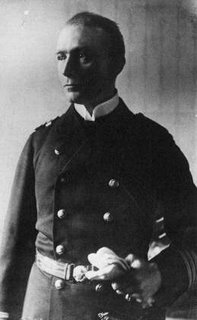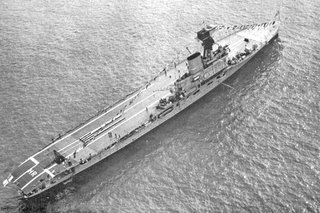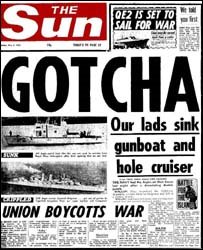It's Wednesday again, and that means it's time for Warship Wednesday again!
Warship Wednesday is a weekly column looking at interesting naval ships from around the world. This week, it's time for...
SMS Emden

The infamous SMS
Emden was the scourge of allied merchant shipping during an extended raiding cruise in the early months of the First World War.
In the latter part of 1914 the strategy of the German surface fleet was to disperse around the globe and wreak havoc amongst Allied Shipping. In just one cruise in the Indian Ocean,
Emden sailed into the history books, reportedly capturing or destroying 23 Allied ships.

At the start of the war
Emden was commanded by Captain Karl von Müller and stationed in the Far East as part of Admiral-Count Maximilian von Spee's German Asiatic Squadron based at the Chinese port of Tsingtao. Müller was a superb cruiser captain, and aware of the situation in Europe in July 1914, took
Emden to sea before war was declared to prevent her being trapped in port by Allied ships. Müller convinced von Spee that
Emden would be most effective operating alone in her prime role of commerce raiding. Her famous cruise to attack British shipping in the Indian Ocean began on 14 August.
Emden's relentless activities, sinking or capturing British ships, caused utter confusion. The British authorities had viewed the Indian Ocean as a safe area for British shipping, now, with
Emden on the loose, that had changed. Moreover, the losses sent insurance rates through the roof, and, as a result, merchant ships could not afford to venture forth from their safe harbours.

The British responded by dispatching a number of ships to hunt down the Müller and the
Emden, but to no effect. In fact Müller had proved to be a cunning captain as well as a superb seaman. He had installed a fake smokestack on
Emden, which made her silhouette extremely similar to the British ship HMS
Yarmouth. This ruse fooled many a merchantman leading to their capture. Thinking they were saluting a friendly vessel they allowed
Emden to close with them, at which point Müller would hoist enemy colours and fire a shot over their bow! At one point 60 Allied ships were chasing this lone German vessel.
Emden's activities were not restrained to capturing Allied shipping. In September 1914 Müller used
Emden's 4.1in guns to bombard the British port of Madras, setting fire to fuel tanks, destroying 350,000 gallons of oil and causing widespread panic. In October Müller sailed the still disguised
Emden straight into Penang harbour, raised the German naval ensign and began shooting up the many Allied vessels in the harbour. Making good his escape, the French ship
Mosquet chased Müller; he made short work of this pursuer quickly sending her to the bottom.
Emden's luck was holding out, but that was about to change.
Müller now decided to attack the Allied Radio station at Direction Island on 9 November 1914. It was a fatal decision. Although the attack was a success, the radio operators had recognised the ship and called for help. The signal reached Captain John Glossop in HMAS
Sydney, an Australian cruiser, who just happened to be close by escorting an allied convoy.
With their landing party still ashore,
Emden spotted the fast approaching
Sydney. Müller immediately put out to sea to engage the new threat, leaving his men ashore. Over the next 90 minutes the two ships engaged in deadly combat.
Sydney's superior 6in guns and her speed eventually told. Despite having one of her guns disabled early in the fight,
Sydney managed to land over 100 hits upon the
Emden, inflicting fatal damage.
It was obvious to Müller that
Emden was going down, to avoid exposing his crew to more danger he ran her onto North Keeling Island. Sydney then chased away a collier that had been sailing with
Emden, and upon returning to the beached ship found her still flying German colours. When his signal calling upon
Emden to surrender was ignored, Glossop opened fire causing more casualties before the German ensign was hauled down.

Müller had lost 131 men killed and 65 wounded, the surviving members of the crew were taken prisoner and the now decrepit
Emden was destroyed. Captain Müller was the last man off his ship.
Fact:
Emden was the last piston engine warship commissioned into the German Navy.
Fact: In Sri Lanka people call a particularly obnoxious person an
Emden.
Fact: The German landing party left behind on Direction Island seized a schooner and sailed for the neutral Dutch territory of Sumatra. They were picked up by a German commercial ship and taken to Turkey, then Germany's ally. Travelling overland the men finally made it back to Germany after an epic journey which began with Emden leaving China.
Fact: In 1917, a 105mm gun from
Emden was installed as a monument in Sydney's Hyde Park. Another is located on display in the Australian War Memorial in Canberra.
SMS Emden Particulars
Emden was built by Kaiserliche Werft of Danzig, launched on May 26, 1908 and commissioned into the German Imperial Navy, on July 10 1909.
Laid down: April 06, 1906
Launched: May 26, 1908
Commissioned: July 10, 1909
Cost: 6,38 Million Reichsmarks
Fate: scuttled
Displacement: 3,364 tons normal
Length: 118 m
Beam: 13.4 m
Draught: 5.3 m
Propulsion: Twelve boilers, two 16,000 shaft horsepower (12 MW) 3-cylinder triple expansion reciprocating steam engines driving two propellers
Speed: 23 knots (43 km/h)
Range: 3,700 miles (6,000 km)
Complement: 360
Armament: ten 4.1in QF in single turrets, and two TT
Armour: Deck 13 mm, Belt 51 mm, Conning tower 102 mm
Emden's confirmed victims:
Indus - 3393 tons
Lovat - 6102 tons
Killin - 3514 tons
Diplomat - 7615 tons
Trabbock - 4014 tons
Kabinga - 4657 tons
Clan Matheson - 4775 tons
King Lud - 3650 tons
Foyle - 4147 tons
Riberia - 4147 tons
Tymeric - 3314 tons
Buresk - 4350 tons
Gryjedale - 4437 tons
Pontoporos - 4049 tons
Troilus - 7562 tons
Clan Grant - 3948 tons
Benmohr - 4806 tons
Chilkana - 5146 tons.
Pourabbel - 473 tons
Exford - 4542 tons
Saint Egbert - 5526 tons
Zhemtchug (Russian Cruiser)
Mousquet (French Destroyer)
Estimated value of captures: £650,000
Estimated value of cargoes: £3,000,000
Next week choose from:
USS Constitution: 'Old Ironsides', the heavy American frigate from the War
of 1812
IJN Yamato: one of two 65,000-ton behemoths built by Japan during WWII
HMS Hermes: the world's first purpose built fleet aircraft carrier
Vote by leaving comments!







































